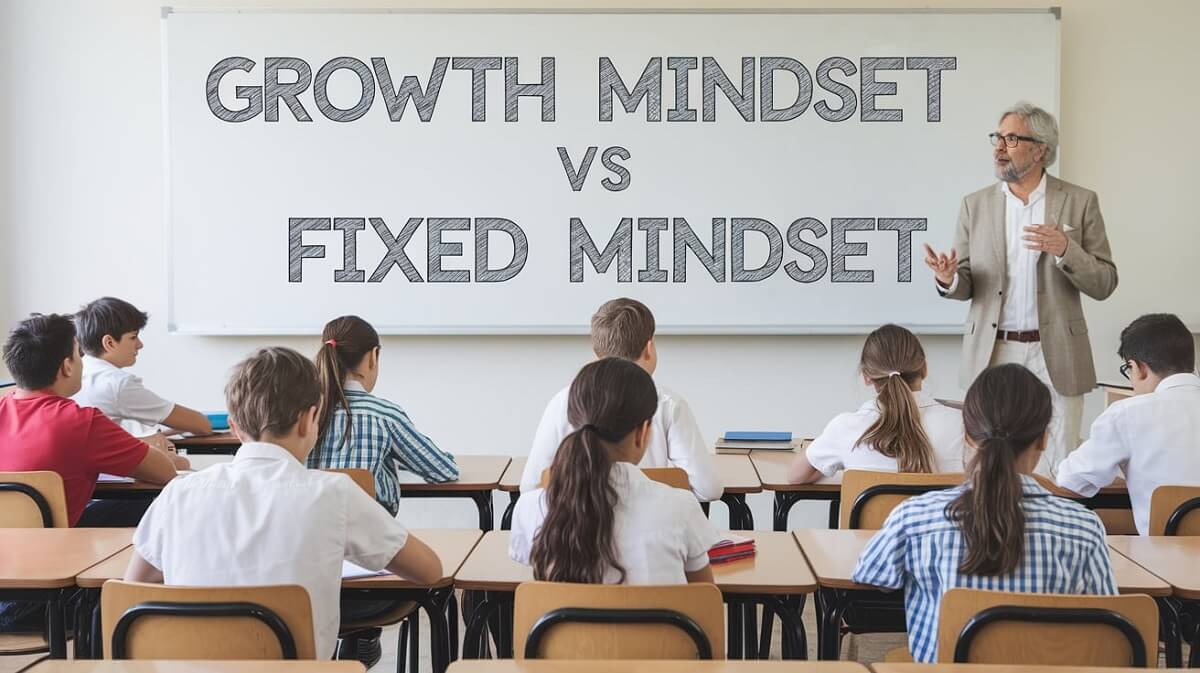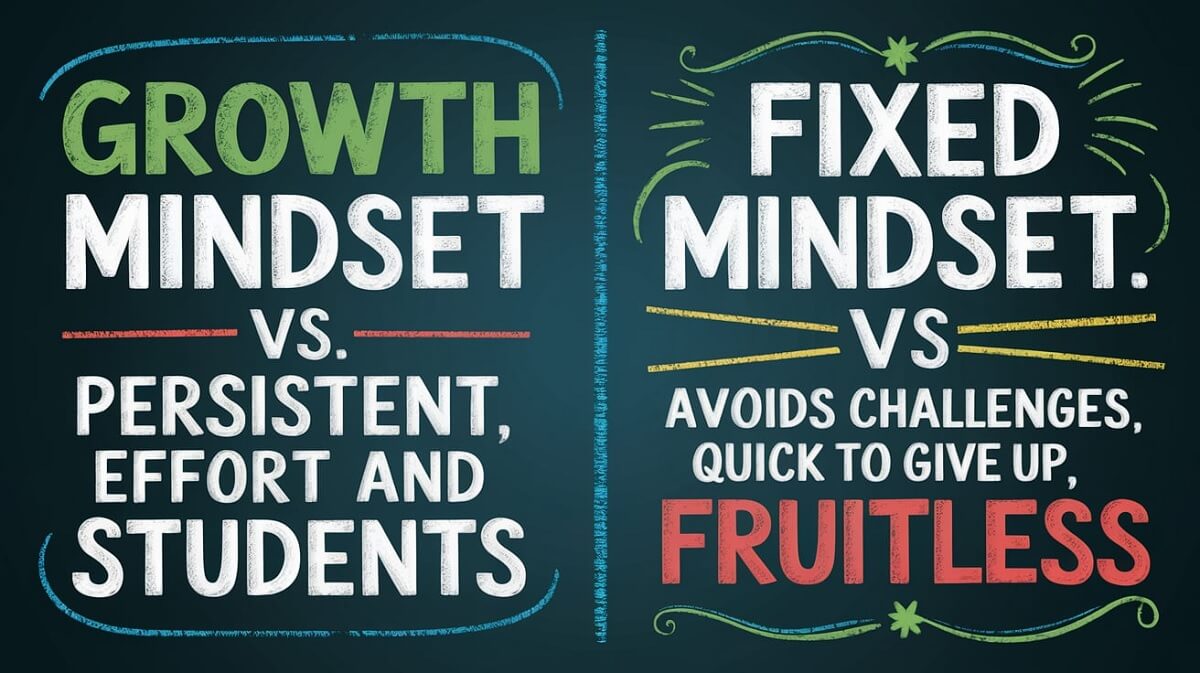
Why Education With a Growth Mindset Changes Outcomes
Education opens opportunities across a lifetime. Grades, skills, and habits from school shape how learners work, lead, and contribute to society. A growth mindset gives that education traction. When learners believe abilities can develop with practice, strategies, and support, they stay with hard tasks longer, ask for feedback, and use better methods. You feel more willing to try again. We see stronger engagement in class and steadier progress over a term.
A fixed mindset blocks that path. If students read setbacks as proof of a limit, they avoid complex tasks. Feedback sounds like a threat, not a guide. A shift in belief—paired with clear strategies—moves behavior from avoidance to action.
Table of Content
- Why Education With a Growth Mindset Changes Outcomes
- What a Growth Mindset Means
- How Mindset Connects to Motivation, Feedback, and Classroom Climate
- Skills and Study Habits That Make Mindset Work
- Language Shifts That Build Strong Beliefs
- Teacher Playbook: Daily and Weekly Routines
- Student Playbook: Simple Steps You Can Start Today
- Family Playbook: Home Language That Supports Learning
- Equity Lens: Mindset With Access and Belonging
- Guardrails: Avoid “False Growth Mindset”
- Assessment, Feedback, and Grading Practices That Support Growth
- Professional Development and Whole-School Culture
- Practical Tools You Can Publish With the Article
- Implementation Roadmap: First 90 Days
- Real-Life Classroom Snapshots
- Key Takeaways
- Closing Section
- FAQs
What a Growth Mindset Means
A growth mindset is a belief: abilities can improve through practice, strategy, and help from others. It does not say talent never matters. It says progress follows from effort that is effective, not effort alone. You try, then you adjust. We coach the next step. Results build over time.
Common myths:
-
“Praise effort no matter what.” Better: praise the process that leads to learning—choice of strategy, review routine, revision plan.
-
“Mindset fixes everything.” Mindset supports progress when classes teach methods, give actionable feedback, and allow chances to revise.
-
“Struggle means failure.” Struggle is often a sign that the task sits near the edge of current skill. That is where learning happens.

How Mindset Connects to Motivation, Feedback, and Classroom Climate
Motivation: Growth beliefs help learners reframe challenge. A tough problem becomes a chance to test a new method. You take the next small step instead of stopping.
Feedback: Students who expect improvement listen for cues that guide change. “Add a counterexample.” “Label the axes.” “Show one more step.” We give feedback that points forward.
Classroom climate: In a room that treats mistakes as information, learners share drafts, ask questions, and try extensions. Trust rises. Time on task rises. Progress follows.
Skills and Study Habits That Make Mindset Work
Mindset explains why you keep going. Study habits explain how you improve. Three pillars help across subjects.
Retrieval Practice
Self-quizzing beats re-reading. It strengthens memory and reveals gaps. Try short quizzes without notes, then check answers. You see what sticks. We then teach how to close the gaps.
Practical ideas:
-
Two-minute warm-up: answer three past questions from memory.
-
End-of-lesson exit ticket: one key fact, one concept link, one question you still have.
-
Weekly “mix-and-match” review with old and new items.
Spacing
Short sessions spread across days outlast one long session. Make a simple schedule: Day 1 learn, Day 3 review, Day 7 review again. You reduce forgetting by touching the same idea more than once. We design homework to follow this rhythm.
Interleaving With Worked Examples
Mix problem types. Compare two methods side by side. A worked example shows each step and the reason for that step. You study the model, then solve a similar task. We rotate problem sets so students select methods with intent, not habit.
Language Shifts That Build Strong Beliefs
Small phrases carry big weight. Replace labels with process talk.
-
From “You’re gifted at math” to “Your table of test cases found the pattern.”
-
From “Any questions?” to “Write one next step you will try in the redo.”
-
From “Almost right” to “Step two needs a check: explain the unit change.”
These swaps do not lower standards. They move attention to action. You learn what to change. We reinforce strategies that lead to better work.
Teacher Playbook: Daily and Weekly Routines
Daily Moves (10–15 minutes total)
-
Warm-up: “My favorite mistake.” Show a common slip from yesterday. Ask learners to spot the step and propose a fix. Short, calm, factual.
-
Two-column feedback: left side teacher notes, right side student action. You pick one change and make it on the spot.
-
Think-alouds: model how to choose a method. We narrate: “I scan for units; I test a boundary case; I label a diagram.”
Weekly Routines
-
Plan–Do–Review cycle: set a micro-goal, work with a chosen strategy, then reflect. The record matters. You track what worked and what did not.
-
Retrieval day: short mixed quiz at midweek. Students correct with a key. We log one error pattern per student and plan the next drill.
-
Revision window: redo one task for credit after visible changes. Learners attach a short note: “What I changed and why.”
Unit-Level Structures
-
Assessment wrappers: before a test, students predict strengths and weak spots; after a test, they classify errors and plan a fix.
-
Mastery checks: short checkpoints on core skills. You move to extension tasks after evidence of readiness.
-
Exemplars with annotations: show high-quality work with margin notes on moves that mattered.
Student Playbook: Simple Steps You Can Start Today
-
Use a timer for 20-minute focus blocks. Pick one strategy, do it, then write one note about the result.
-
Create a “wins” list each week. One line per skill you improved. Small gains count.
-
Replace “I can’t do this” with “I can’t do this yet.” Then add two next steps.
-
After feedback, rewrite one problem or paragraph from scratch. Compare to the model. Mark differences.
-
Keep a strategy log: date, topic, method used, result, next action. We read these logs during conferences to guide support.
Family Playbook: Home Language That Supports Learning
-
Praise the method: “You tested ideas with flashcards, then you taught me one step. That shows planning.”
-
Tell stories about your own revisions at home or work. Show drafts, not only final products.
-
Ask “What did you try?” and “What will you try next?” Short talks beat long lectures.
Equity Lens: Mindset With Access and Belonging
Growth beliefs help when learners have access to challenge, materials, and time. Fair policies matter. Extra practice time, clear notes, and safe spaces for questions matter. A sense of belonging lowers fear and lifts participation. We craft routines so every student speaks, writes, and revises each week. You see your voice on the page or board. That visibility builds confidence.
Mindset work should not replace resources. It sits beside tutoring, strong curricula, and supportive families. When all parts line up—beliefs, methods, time, and trust—gains reach more students.
Guardrails: Avoid “False Growth Mindset”
False growth mindset praises effort without guidance. It treats hard work as the target instead of progress. Real growth mindset links effort to strategy and results.
Signs of drift and quick fixes:
-
Posters without practice. A slogan on the wall changes little if tasks never allow revision.
-
Praise with no next step. “Nice job” tells nothing about what to change.
-
Endless redos with no reteach. A second chance needs a plan.
Corrections that work:
-
Always pair feedback with an action. One step, clear deadline.
-
Track revision quality, not only completion.
-
Share data on progress so learners see growth over time.
Assessment, Feedback, and Grading Practices That Support Growth
Feedback Levels
-
Task level: accuracy and completeness. Example: “You missed units on lines 3 and 4.”
-
Process level: the method. Example: “Try a table to compare rates.”
-
Self-regulation level: planning and monitoring. Example: “Set a checkpoint after step three.”
A balance across levels helps students fix the current piece and improve the next piece. You leave with one concrete change. We follow up on that change.
Retakes That Teach
Retakes work when they teach, not when they rescue. A strong retake plan includes:
-
A short reteach or clinic before the redo.
-
A checklist of skills tied to the rubric.
-
A reflection line: “What I changed and why.”
Grades signal progress. Comments guide progress. Both matter. When policies reward visible growth, students try harder tasks sooner and accept feedback sooner.
Professional Development and Whole-School Culture
Teachers need time, shared language, and examples. Short workshops help, yet practice grows through cycles: try, observe, reflect, and refine. We plan department goals that fit local needs. For example:
-
A shared bank of annotated exemplars and feedback stems.
-
A calendar for schoolwide retrieval days.
-
Cross-observations that focus on one routine, such as two-column feedback.
Leaders keep messages steady across classes. Family notes, class syllabi, and assemblies use the same terms: process, strategies, revision, and evidence of growth. You hear one set of ideas in all rooms.
Practical Tools You Can Publish With the Article
-
Student checklist for revision: “What I kept, what I changed, what I will try next.”
-
Teacher feedback stems: “Your comparison shows…, Next, try…, Look at example B for…”
-
Parent talk starters: “What part felt hard today? What did that teach you about your plan?”
-
Retrieval schedule template: weekly blocks for each subject.
These tools make ideas visible and repeatable. A reader can use them the same day.
Implementation Roadmap: First 90 Days
Weeks 1–3: Set the Foundation
-
Agree on shared language. Staff adopt a short list of feedback stems.
-
Collect baseline information through a quick student check: comfort with challenge, typical study method, and one goal for the term.
-
Post two exemplars in each course with annotations on strategy.
Weeks 4–6: Build Classroom Routines
-
Launch a weekly retrieval day. Start with five mixed questions, then reflect on one.
-
Start two-column feedback. Keep the student action small and fast.
-
Add a five-minute Plan–Do–Review at the end of one lesson per week.
Weeks 7–9: Align Assessment and Revision
-
Introduce one mastery checkpoint per unit. Students who show readiness move to extension tasks.
-
Offer a structured retake: reteach clinic, checklist, redo, short reflection.
-
Share class-wide progress snapshots: number of revisions, average change per skill, common strengths.
Weeks 10–12: Reflect and Scale
-
Gather student voice: short prompts on which routines help most and what to adjust.
-
Share teacher-to-teacher notes on which stems or exemplars landed best.
-
Decide what to scale schoolwide next term: more retrieval, more exemplars, or more clinics.
Real-Life Classroom Snapshots
Middle School Science
A teacher opens each class with a “favorite mistake” from the prior lab. Students identify the step where the error started, then write one fix. Over a term, students show fewer unit slips and stronger graph labels. Confidence rises for learners who once stayed silent, because the class treats error-finding as normal work.
First-Year University Math
An instructor uses short mastery checks. Each check covers one core skill. Students who pass move to challenge sets; others visit a 15-minute clinic before a redo. Attendance at clinics stays high, and the gap between first and second attempts narrows. The gradebook shows progress rather than one-shot scores.
Grade 4 Reading
Reading groups keep a strategy log. After each passage, students mark the move they used—predict, question, clarify, summarize—and add a one-line note on how it helped. By midterm, more students choose a second strategy without prompting. Parent conferences use the logs to show growth with concrete examples.

Key Takeaways
-
Growth mindset shapes how learners respond to challenge. With clear strategies and steady feedback, it supports steady gains.
-
Feedback that points forward, not labels, helps students act. You see the next move, not a verdict.
-
Retrieval, spacing, and worked examples give mindset a method. Results follow practice, reflection, and revision.
-
Fair policies and a warm climate help all students take risks. Access and belonging travel with mindset.
-
Progress feels real when schools track visible change: revisions, strategy use, and entry into harder tasks.
Closing Section
Mindset is a belief. Learning is a set of actions. When You and We join those two—belief and action—students move from “I can’t” to “I can improve.” That shift does not depend on slogans. It rests on daily work: short retrieval, clear feedback, and a calm space for second tries. Over weeks, learners see growth on paper and feel growth in confidence. That is student excellence in practice.
FAQs
How can I start if my class already fears mistakes?
Begin with teacher-owned errors. Share a short example from your own work. Model a fix in plain steps. Invite students to mark one change on their own drafts. Keep the tone steady and routine.
What is one practice I can add this week?
Run a five-minute Plan–Do–Review at lesson end. Ask learners to write one next step for the same skill. Collect the cards. Use them to plan the next mini-lesson.
How do I use praise without hurting resilience?
Praise process with specifics: method, effort that mattered, and next step. Avoid labels like “genius” or “natural.” Students then link praise to actions they can repeat.
What should a retake include?
A short clinic, a checklist tied to the rubric, and a reflection line. The redo then shows a concrete change. Grades mark growth, and students learn how to improve the next task.
How do parents help at home?
Keep talk short and practical. Ask “What did you try?” and “What will you try next?” Praise the plan and the follow-through. Share your own drafts and revisions so effort with strategy feels normal.
Education

